The trees at Bukit Brown include a number of figs (Ficus sp), with clumps of bright green fruit sprouting from the trunk – a condition botanists call cauliflory.
Some of the tree trunks are decorated with delicate clumps of fungi.
Our stroll was more of an invertebrate walk then anything else, and some of my photographic subjects took a bit of spotting! This appears to be a very young snail of some sort.
Somewhat larger was this stilt fly (Family Micropezidae, Subfamily Taeniapterinae). Notice the white-tipped legs, with the front pair held up and out as though they were antennae. This is apparently deliberate mimicry of some species of ichneumon wasp. The flies wave their front legs up and down to increase the illusion that this otherwise harmless insect is a stinging wasp actively searching for prey.
This is the nymph of a flatid planthopper (Family Flatidae), covered with long waxy filaments that help hide it from predators and keep it from drying out.
Beetles, of course, were everywhere (as they always are). This is a hind-end view of a ladybug (Family Coccinellidae), possibly a species of Henosepilachna (for a gallery of Singapore ladybugs, photographed much more satisfactorily than this one, see here).
The tree trunks along our path were decorated with various species of fungus beetle. This appears to be Eumorphus tetraspilotus. It belongs to the family Erotylidae, oddly known as pleasing fungus beetles (they do feed on fruiting bodies of fungi that live on decaying wood, but other than their attractive colour pattern I am not sure what is particularly pleasing about them).
These are also fungus beetles. They may be Eumorphus too, but I am not sure which of the many species these represent (the two photos seem to be of two different species).
This is a longicorn beetle, probably Coptops annulipes (Family Cerambycidae, Subfamily Lamiinae, Tribe Mesosini) displaying a habit this species apparently has of folding its antennae and playing dead (and thereby becoming an excellent photographic model).
I'm not sure what this attractive little land snail is - perhaps some Singapore naturalist could help me? It has a somewhat thickened lip, so it may belong to the varied and colourful genus Amphidromus, but it doesn't fit anything I have been able to find on the internet. It could also be one of the introduced African land snails (Achatina), but, again, I can't find a match.
This appears to be an assassin bug enjoying a meal of snail eggs.
Spiders ranged from this Brown Grass Spider (Polyboea vulpina, Family Pisauridae)...
...to this almost frighteningly impressive Hermit or Malabar Spider (Nephilengys malabarensis, Family Araneidae) weaving its web by the cemetery gate.
Mycalesis butterflies are the very devil to identify, but I believe these to be Long Brand Bush Browns (M. visala phamis) based on the pattern of the forewing.
These much drabber butterflies may be the very similar (and commoner) Dark Brand Bush Brown (Mycalesis mineus macromalayana). Both bush browns prefer shaded grassy areas, both in parks and urban woodland.
The subtly handsome Common Faun (Faunis canens arcesilas) is a butterfly of the forest understory, where it feeds on overripe fruit and, like many similar forest floor butterflies in the brush-footed butterfly family Nymphalidae, may never visit a flower.
The Malay Baron (Euthalia monina monina) is another common forest-floor nymphalid, the commonest of its genus in Singapore.
The Cruiser (Vindula dejone erotella) is a forest butterfly too, but in my experience it is more likely to show up along the forest edge, in the weedy vegetation along the trailside. If you are perspiring, it may well land on you.
The Chocolate Pansy (Junonia iphita) is one of a group of open-country butterflies, but it appears to be more of an edge species than the other Junonias.
Here, though, I found it with the Peacock Pansy (Junonia almana), so it did not have the forest edge all to itself. Peacock Pansies, as a rule, are more likely to turn up in sunny open areas.
Though the Branded Imperial (Eooxylides tharis distanti) is the commonest of a number of similar, long-tailed hairstreaks, no matter how often I see one it never fails to impress me (I still recall my sheer astonishment the first time I encountered one, at Borneo Highlands in Sarawak).
The Yellow Grass Dart (Taractrocera archias quinta) gets its name from its darting flight (and, I suppose, from its yellowish colouration and the fact that, like many similar skippers, its caterpillars dine on grasses). The "delta-wing" posture in these photos is typical of grass skippers worldwide.
Wooded areas aren't normally the easiest places to find dragonflies (aside from forest specialists that I seem to have the devil of a time finding anyway), and there didn't appear to be a stream or pond in the immediate vicinity, but we nonetheless found a number of species patrolling the vegetation along our path. I'm not that great at identifying female (or young male) dragonflies, many of which look alike to me, but these appear to be one or the other of the common species of Neurothemis.
With the adult males, of course, the task of identification (at least to genus) is much easier. This is Neurothemis fluctuans, one of the commonest dragonflies in Singapore.
Orthetrum dragonflies are also a lot easier to identify as adult males. This is Orthetrum chrysis.
Females are a lot trickier (at least for me), though if you can get a good look at the wing vans toon it is normally easy to identify it to genus. Orthetrum has a complete antenodal cross win in the forewing (which means, in English, that the vein immediately in front of the wing node - the slight bend on the leading edge of the wing - completely crosses the first vein parallel to the wing edge instead of stopping short where the two veins meet).
Deciding which species you are dealing with is another matter. I think this one is a teneral (that is, newly emerged) female Orthetrum glaucum.
This dingy individual may be Orthetrum glaucum too, but I'm none too sure.
Agrionoptera insignis, on the other hand, is a lot easier to identify (and considerably harder to find, at least in my experience).
Here is one of the most distinctive of female dragonflies (and a true forest species): Tyriobapta torrida, called the Treehugger in Singapore. I usually find females perching on the trunk of a tree, doing their best to blend in to the bark. The strongly-patterned males would find this a lot more difficult to pull off (though they do try), and they are more likely to be defending territories around small forest ponds.
As Cynthia is demonstrating here, Treehuggers are apparently so sure of their camouflage that they will tolerate an extremely close approach. And this gives me an excuse to thank Cynthia, once again, for hauling me away from Royce's bedside to a bit of local nature - always the best way (for me at least) to relax in a trying personal situation.
This, by the way, is the 300th posting on A Wandering Naturalist. Thanks to my readers (should there still be any) who have stuck with me this far!
This dingy individual may be Orthetrum glaucum too, but I'm none too sure.
Agrionoptera insignis, on the other hand, is a lot easier to identify (and considerably harder to find, at least in my experience).
Here is one of the most distinctive of female dragonflies (and a true forest species): Tyriobapta torrida, called the Treehugger in Singapore. I usually find females perching on the trunk of a tree, doing their best to blend in to the bark. The strongly-patterned males would find this a lot more difficult to pull off (though they do try), and they are more likely to be defending territories around small forest ponds.
As Cynthia is demonstrating here, Treehuggers are apparently so sure of their camouflage that they will tolerate an extremely close approach. And this gives me an excuse to thank Cynthia, once again, for hauling me away from Royce's bedside to a bit of local nature - always the best way (for me at least) to relax in a trying personal situation.
This, by the way, is the 300th posting on A Wandering Naturalist. Thanks to my readers (should there still be any) who have stuck with me this far!























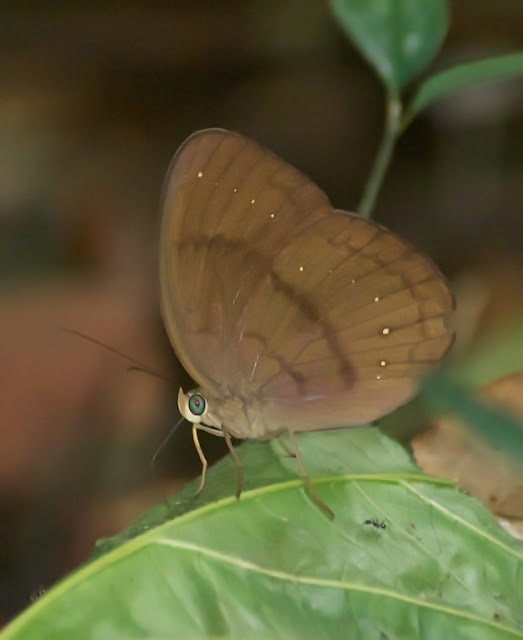









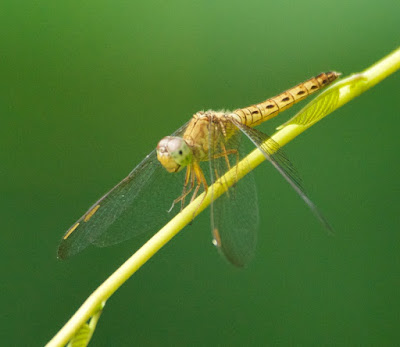



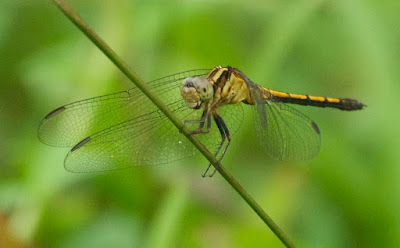


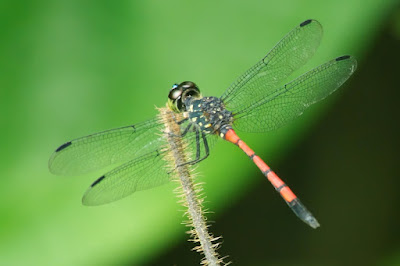
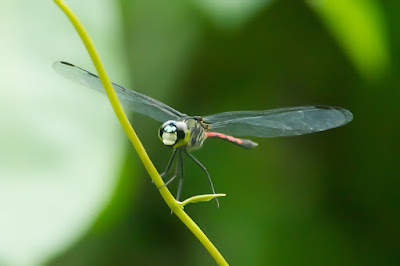



No comments:
Post a Comment